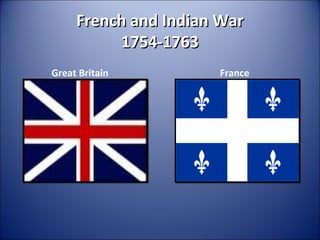
French and Indian War
- 1. French and Indian War 1754-1763 Great Britain France
- 2. Not the French vs. the Indians! • The war actually was the French and Indians vs. Great Britain. • The British controlled much of the 13 original colonies. • The French controlled the middle portion of North America.
- 3. Can’t We All Get Along? • So what started this war • The French didn’t want and where did the the British in their American colonists territory. stand? • Both sides disagreed • Basically, it came down over the land, and to greed. fighting broke out. • The British wanted to • The American colonists control trade routes sided with the British from the colonies into and the Indians more or French territory. less sided with the French.
- 4. Picking Sides • The American colonists • The Indians sided with sided with the British the French (mostly) because most of the because they feared colonists came from that the British would Great Britain. steal their land. • Think of it this way: • Some Indians helped Great Britain was the the British so they father, the colonists wouldn’t lose their land. were the children. • Some Indian groups • We needed them to stayed neutral. protect us.
- 5. British Uniforms British uniforms stood out due to their bright red coloring.
- 6. The British Army • The British Army was • Their army was the the greatest army in the biggest army in the world. world by far. • Their soldiers had the • They had the best best training. strategies and tactics of • Their soldiers had the any army. best weapons. • They simply did not lose • They had the best battles or wars! commanders.
- 7. French Uniforms The French wore a white and blue uniform.
- 8. The French Army • The French had a large army as well. • They were a very well trained army. • They also had the Indians helping them out. • Most Indians spoke French because the French came from Canada. • Many Indian tribes traded with the French settlers.
- 9. Weapons of War “Brown Bess” Musket Flintlock Pistols
- 10. Bullets and Gun Powder Animal Horn full of Gun Powder Bullets
- 11. Firing the Musket Pull back on the hammer Put one bullet in Pour in some gun powder Pull the trigger Use the rod to push the bullet and gun to fire powder down the barrel of the gun
- 12. Not as easy as it looks! • An experienced soldier would be able to reload their musket in about 15 seconds. • When in battle, a soldier was expected to reload their musket quickly. They had about 5-8 seconds to reload. • Since the musket only held one bullet at a time, you had to reload after EVERY shot!
- 13. The Big Guns Cannon Balls Cannon Cannons were devastating weapons that could fire from long distances. Cannon balls were smaller then a bowling ball.
- 14. Indians • Many Indian tribes decided to join the French Army because the British Army wanted to take their land and cut off their supply routes. • The Indians fought very aggressively and in ways the French and British had never seen before.
- 15. Indian Weapons Bow and Arrow Hatchet
- 16. A New Way to Fight • The European way of • The Indian way of fighting was based fighting was much more around honor and brutal then the respect. Europeans way of • Two sides faced each fighting. other in lines or rows. • They preferred hiding in • Each side traded shots the woods and using at each other. surprise attacks on their • A truce was formed enemies. when one side gave in. • The Indians did not believe in giving up.
- 17. So Which Side Won? • Vicious fighting continued until 1763 when the British and the American colonists pushed back the French and the Indians. • With the French defeated, the British and its colonists were free to greatly expand their territories in America. • However, all did not end well. Soon the American colonists would find themselves in a conflict with its British brothers.